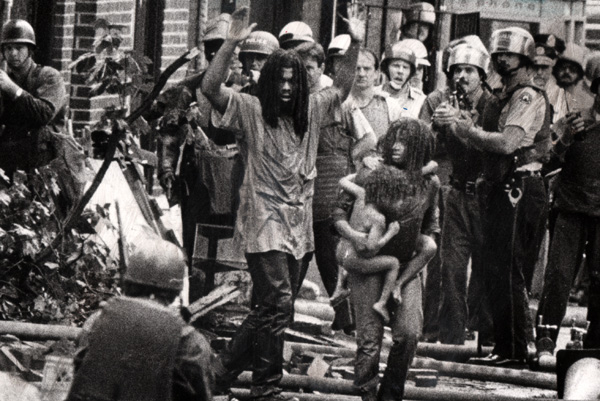Comprised entirely of archival footage that’s been edited together to form a cracking documentary and political thriller (with the occasional title or subtitle to add context), Let the Fire Burn isn’t so much about a enigmatic cult-like political organization or the mishandling of their rights by local politicians as it’s about the people just outside the margins of the story. Jason Osder’s look at a 1985 Philadelphia standoff – one that ended in a tragic five alarm fire that destroyed 61 homes and killed 11 people – is more interesting in terms of what it never mentions: the poor everyday citizens that were caught in the crossfire of two obstinate groups that pretended to work in their best interests.
Predominantly using newscasts, selections from a 1976 TV documentary, and the actual testimonies provided to an independent counsel five months after things all went to hell, Osder looks at the clash between the organization MOVE and the Philadelphia power structure that wanted to silence them. Not even well liked in their own neighbourhood, MOVE was a back-to-basics and largely African American organization founded by John Africa that created their own kinds of inner city communes. They lived almost entirely without the aid of technology and they kept arms that were sometimes not even operational. They didn’t even let their kids eat cooked food and often didn’t bother clothing them.
Still, there had to be better ways to handle the group than how former mayors Frank Rizzo and Wilson Goode handled them. Tough former cop Rizzo forced MOVE out of their original neighbourhood, openly daring the group to wage war in the streets and instituting a raid that claimed the life of a child. And despite being a black mayor that people looked to for stability in a crumbling and largely minority populated city, Goode had it even worse: forcibly trying to evict a group that had already moved and grown more hostile. His administration oversaw not only the neighbourhood destroying fire the title refers to, but also to a daylong shootout (started apparently by the police themselves) that was so overblown that the cops had to send out for more cases of ammunition.
Osder makes neither immediate side look all that sympathetic. For all their non-violent tendencies, MOVE wasn’t a particularly nice organization to be around. They were bullies with questionable parenting skills that flaunted their own self-educated ways to such an extent that it’s clear that at some point they gave up their own ideals for a shot at outright martyrdom. The Philadelphian government and especially the police didn’t even seem to care about all the innocents who also called the neighbourhood home, and not once is any remorse shown for their efforts to squash the group by any means necessary.
And that’s the true tragedy of Osder’s work. It’s easy to place yourself in the shoes of a local resident at the time because the film itself is outlining a form of psychological warfare. Numerous times both sides of the issue will force viewers to the point of being flabbergasted that no one could come up with better solutions. They’re groups designed to work within the best interests of the people – and with mostly different ideas of what those best interests should be – that let down all but their most hardened supporters and followers. With neither group a particularly large majority in such a dense neighbourhood in one of the biggest cities in the US, it’s unconscionable that they would wage such an open war among people who (although they were largely evacuated during the larger raid) were left out of the discussion. It’s a depressing, no-win situation, but one that should be studied and not immediately forgotten.






Comments